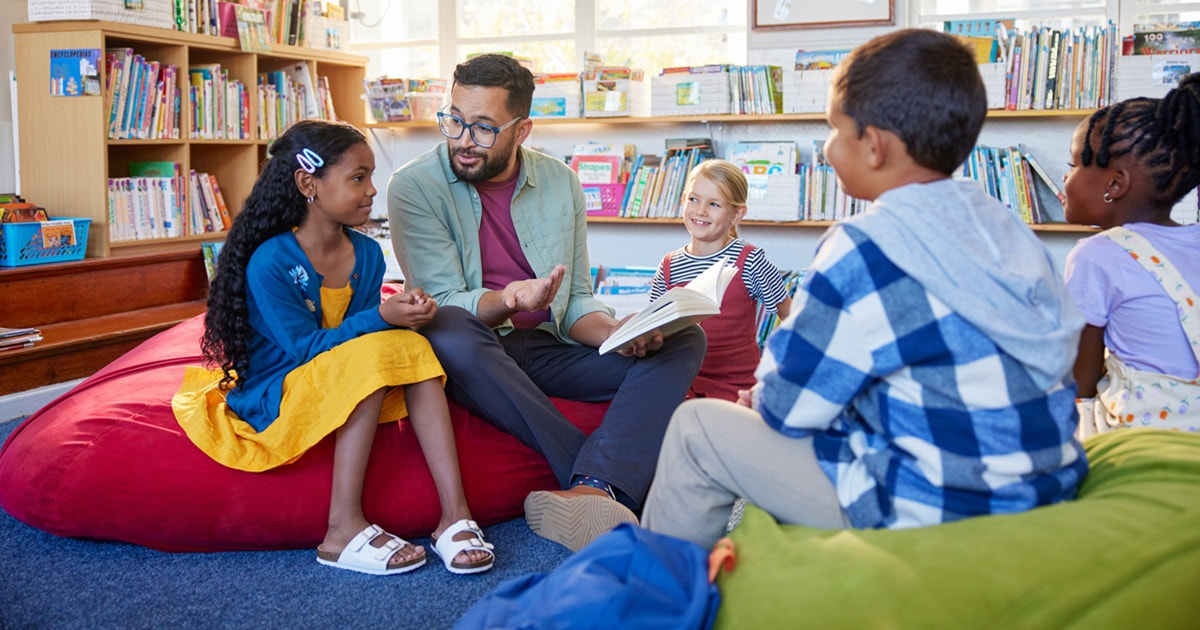
Promote Inclusion in the Classroom With Tips and Activities
113
Your classroom brings together learners from different backgrounds, and their unique identities, abilities, and perspectives should be acknowledged and valued. Promote inclusion in the classroom with practical strategies, activities, and tips that build empathy and awareness of others. From kindergarten to high school, make it your mission to empower every student to thrive.
An inclusive classroom values every student’s voice and builds a culture of kindness where students share responsibility for upholding these expectations. According to the Department of Education, these basic principles guide inclusion in education: fostering a sense of belonging, supporting students’ emotional and social well-being, and ensuring that teaching and administration actively promote inclusion.
Because inclusion in the classroom doesn’t happen overnight, consistently use strategies in your teaching and classroom management to help promote success.
Start the year by celebrating inclusion in the classroom
Creating a sense of inclusion takes intentional effort, especially at the start of the year. It begins by setting clear guidelines and modeling the inclusive behaviors you want to see through your teaching practices. Along with icebreakers that celebrate student strengths and traditions, simple pair-and-share activities can help set a tone of respect and belonging.
Back to School First Day of School Activities – Diversity and Inclusion Bandaid
By Lotts of Learning
Grades: 2nd-6th
It can be challenging for students to understand that fair doesn’t always mean equal, but this lesson plan breaks the concept down into simple, easy-to-understand language. The 39-page PowerPoint includes everything you need to teach the lesson effectively, and the resource also provides ailment cards for students to use.
Use books as conversation starters
Whether you’re teaching high schoolers or younger elementary students, your bookshelf can be a great starting point for discussions about inclusion and diversity. Choose stories featuring characters from different cultures, abilities, and family structures. Read the stories or their summaries together, then talk about the characters and how their experiences relate to the real world. You can scaffold these conversations with activities that help build awareness and appreciation of differences.
Diversity And Inclusion Read Aloud Activities For The Book All Are Welcome
By Counselor Chelsey
Grades: K-2nd
This resource is based on the book All Are Welcome and includes two engaging activities to support inclusion in the classroom. You’ll also receive task cards and posters to help reinforce the message and create a welcoming environment for all students.
Perspective Through Picture Books: Create Your Own! Template and Video Guide
By LaNesha Tabb Teaches*
Grades: K-1st
This resource centers on exploring different perspectives and can be tailored to fit any text you’re working with. It includes a PowerPoint, a video, and written support to help deepen understanding.
Talk about current events to gain a deeper understanding
Equity, fairness, and justice come alive when you explore them through current events and social topics. For example, you might discuss a recent news story about access to clean water and invite students to share their thoughts while practicing respectful listening.
Talk About It: Real World Issues
By Read Like a Rockstar*
Grades: 1st-3rd
Get five different lessons that use current events to explore diversity, race, identity, bias, and stereotypes. Each lesson includes eBooks with kid-friendly information on the topic, along with thoughtful prompts designed to spark meaningful discussions.
Foster exploration and celebration of student identities
Encourage students to learn about each other’s cultures, abilities, and differences. Talk about how these diverse backgrounds help build a strong, inclusive community. For elementary students, cultural show-and-tells work well, while high schoolers might interview family members and share their stories. You can also have students of all ages interview one another to deepen understanding and promote inclusion.
Identity, Cultural Diversity and Inclusion, & Social Justice Activities
By The Responsive Counselor
Grades: 3rd-6th
Bring your class together with five lesson plans. Through discussions about diversity, differences, stereotypes, recognizing injustices, and taking action, students build important social justice skills. The resource includes over 20 slides filled with activities and guided discussions to support meaningful learning.
Use writing prompts to deepen thinking about fairness and equity in the classroom
Help students reflect on their thoughts about inclusion and deepen their understanding of bias, empathy, and fairness by using scenario-based reflections. Students can share their perspectives with classmates and propose solutions to injustices they notice, working together to create a more inclusive environment. These activities not only develop problem-solving skills but also strengthen social awareness.
Diversity and Inclusion Prompts, Social Justice, Inclusion Activities and Lesson
By The Core Coaches
Grades: K-6th
This resource offers downloadable materials for both K-2nd and 3rd-6th grades. The Google Slides include discussion cards, projectable questions, glossary pages, printable posters, and worksheets.
Share narratives that model inclusive behavior
Modeling inclusive behavior is essential because, as a teacher, you are your students’ first example of what inclusion in the classroom should look like. At the same time, inviting students to share their own stories fosters a culture where everyone feels valued. Encourage students to ask a classmate to join a game or a debate. In a high school setting, inclusion might look like a student actively listening and thoughtfully respecting a classmate’s communication style, even when it’s different from their own. By providing these concrete examples, you create a strong, lived culture of diversity and inclusivity that everyone can embrace.
FREE Social Stories Accepting Differences Inclusion Social Skills Activities
By One Giggle at a Time
Grades: PreK-4th
Standards: CCSSRI.K.1, K.2, K.7
This resource combines social-emotional learning activities with social skills stories written in kid-friendly language. It requires no preparation, making it perfect to use as a substitute lesson plan. The focus is on acceptance, empathy, and friendship.
Invite students to reflect on their experiences
Every student in your classroom has a story to share, and it’s important to provide them with opportunities to reflect on their experiences, feelings, and beliefs throughout their education. Instead of keeping these reflections private in journals, consider having students share their thoughts in small groups. This allows them to process big emotions together and explore different perspectives. Just be sure your prompts focus on meaningful social topics like identity, culture, and inclusion.
Identity Reflection Journal | Teach For Justice Resource
By Classroom de Rollins by Jazz Rollins
Grades: 6th-12th
Help students build and explore their identities with printable journaling pages designed for multiple grade levels. This resource includes a suggested lesson plan and can easily be shared digitally through Google Slides.
Benefits of Inclusion in the Classroom
An inclusive classroom is more than just a physically accessible space with classroom organization that includes flexible seating and adaptable materials. It’s a welcoming environment filled with visual reminders of what diversity looks like and means. You can use a variety of teaching methods, so every student feels supported, encourage learners to understand and value their classmates’ perspectives, and provide positive and warm report card comments to encourage students.
Recent research published in Teaching and Teacher Education shows that inclusion in the classroom supports academic growth and fosters positive feelings of well-being for students.
Inclusion in the classroom also:
- Strengthens empathy
- Deepens social awareness
- Reduces bias
- Challenges stereotypes
- Builds adaptability and flexibility
- Encourages discussions from multiple perspectives
- Promotes equity in learning opportunities
- Fosters leadership in every student
- Models inclusion as a shared moral responsibility
Equity in the classroom can take many forms. For example, students might work together on an inquiry-based learning project or share different perspectives after reading about a social justice topic.
Consider incorporating these practices into your teaching:
- Integrate Cooperative Learning: Create dynamic groups, so students can engage with the varied and diverse perspectives of their classmates.
- Provide Multiple Ways for Students to Demonstrate Learning: Offer assignments with multiple entry points and options, so students can show their learning in ways that match their strengths and styles.
- Start the Day With an Inclusion Circle: Begin the morning with a prompt about inclusion, and invite each student to share their thoughts and feelings.
- Design a Language Wall: Celebrate the languages spoken in your classroom and around the world, so students see that every language and culture matters.
- Build a Library With Recommended Family Books: Ask families to recommend books for a classroom library that reflects everyone’s culture.
- Celebrate Lesser-Known Holidays: Discuss and observe lesser-known holidays to broaden students’ understanding of their classmates and the world.
- Regularly Reflect on and Adapt Practices: Adjust your teaching methods regularly to ensure all students’ abilities and differences are included.
- Establish Clear, Inclusive Classroom Norms: Model inclusion by setting clear rules and expectations that promote respect and belonging.
Create an inclusive classroom with TPT resources
Inclusion in the classroom can look different in elementary versus high school settings, but the core goal is the same: creating an atmosphere that celebrates differences while fostering respect and empathy among learners. TPT offers a variety of inclusion lessons, activities, and visuals to help make your classroom a truly diverse learning environment. It’s important to let every student who walks through your door know they belong, are welcome, and are in a safe space.
Source link











